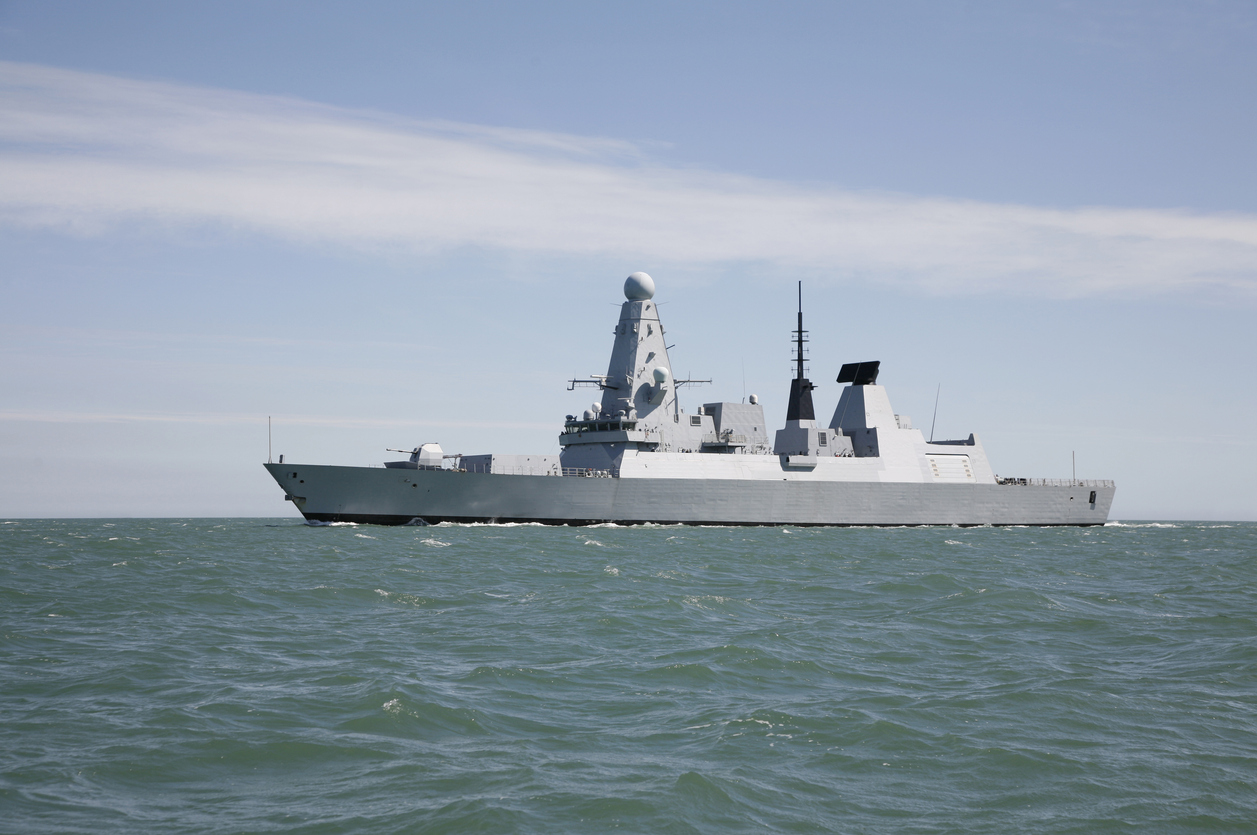
India’s Stealth Ships: Lethal And Silent Power Projection

19 December 2021. The Indian Navy (IN), in order to commemorate an earlier, but equally significant Operation VIJAY (the day the IN liberated Goa from the Portuguese 60 years ago), put to sea INS Mormugao on her maiden sea sortie. INS Mormugao is India’s second Project 15B Class indigenous stealth destroyer and is due to be commissioned in mid-2022.
What is a Stealth Ship?
A stealth ship employs stealth technology construction techniques in an effort to ensure that it is harder to detect by one or more of radar, visual, sonar, and infrared methods.
-Wikipedia
The use of material and technology to produce a smaller radar cross-section or to reduce sound and electronic emissions are all common attributes of what is commonly considered a stealth ship.
-Centre for International Maritime Security
Surface Naval warships can be detected using Sound Detection & Ranging (SONAR), radars or Infra-Red (IR) detectors. However, the signature, reflectivity and Radar Cross Section (RCS) of the ship can be significantly reduced by the following measures/ technology- use of suitable visual camouflage, construction with low reflectivity composite materials (fibreglass/carbon fibre/PVC), ensuring the superstructure is flush with the hull with minimum projections, use of tumblehome hull (a hull that grows narrower above the waterline), reducing acoustic signature (use of muffled exhaust systems/non-cavitating propeller shapes that reduce formation of air bubbles [cavitation]/use of water-jets for propulsion), reduction of thermal emission (by mixing hot engine exhaust with cold air), reducing Electromagnetic (EM) emissions (by greater use of passive sensors/minimum use of radio) and avoiding perpendicular surfaces (right angles) in design. This allows the ship to operate with stealth while still retaining the ability to detect the adversary’s ships, thus according significant tactical advantage to such stealth ships.
Apropos, full stealth ships would incorporate all of the above features in order to reduce their signature across all detection mediums, including visual, EM, acoustic, radar and thermal; while partial stealth ships would incorporate some of these features (including as retrospective add-ons) aimed at partially reducing signature/RCS.
Why does India Need Stealth Ships?
Defence of India’s coastline (in excess of 7500 km), island territories and its Exclusive Economic Zone presents a daunting security challenge for the IN. While swift reaction to hostile Naval presence on the high seas/ littoral regions is well achieved by our seaboard-based fleets, there is also a requirement to project maritime deterrence. This is achieved, among other means, by advertising the wherewithal to strike an adversary’s maritime assets with minimal warning, by obscuring the visual/ electronic detection capability at the adversary’s disposal. Stealth ship technology achieves precisely this aim, by allowing our stealth ships to bring their lethality to bear upon an adversary’s coastal or Naval assets, while significantly reducing the window available to the adversary between detection and counter-action. Further, as both China and Pakistan possess stealth ships (the latter as acquisitions from China), it is incumbent that the IN also pursues and incorporates stealth technology in its warships, as an effective counter. India’s stealth ship capabilities have been aptly showcased- one such instance was in May 2016, when a flotilla which included two stealth guided-missile frigates, under the Flag Officer Commanding Eastern Fleet set sail for the South China Sea and operated alongside other regional Navies, in a demonstration of the IN’s reach and commitment to India’s ‘Act East’ policy.
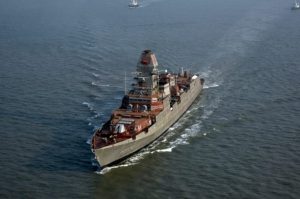
INS Mormugao: Maiden Sea Voyage
India’s Stealth Ship Fleet
India’s tryst with surface stealth ships began at the turn of the millennium, with the development and commissioning of the Shivalik Class frigates under Project 17, as part of the Maritime Capability Perspective Plan (MCPP) of the IN. While all the below-mentioned ships boast significant armament and sensor packages, this article will focus on the broad aspects of stealth technology that these vessels do/will incorporate. The design specifications drawn up by the Directorate of Naval Design (DND) for the Shivalik Class frigates incorporated ‘advanced signature suppression and signature management features’. Three ships of the Shivalik Class were formally ordered by the IN in early 1999 and commissioned between April 2010 and July 2012. These will be followed by seven Nilgiri Class guided-missile frigates being constructed by Mazgaon Dock Shipbuilders Limited (MDSL- a Defence PSU located in Mumbai) and Garden Reach Shipbuilders & Engineers (GRSE- a Kolkata based Defence PSU) under Project 17A, set to be commissioned between August 2022 and August 2025. These ships will have a substantial stealth profile with the use of composite materials, radar-absorbent coating and dissipated hull temperature emissions, leading to a diminished RCS and Infra-Red (IR) profile. The physical shape which includes an enclosed mooring deck, deck-mounted flush weapon systems and reduced antennae population would also lend to stealth. Acoustic reduction will be achieved by use of non-cavitating propellers and ‘acoustic enclosures’ to reduce acoustic emissions of the ship’s engines, driveshaft and transmission systems.
Apart from these indigenous stealth frigates, the Talwar Class stealth guided-missile frigates have been designed and constructed by Russia for the IN, as an improvement over the Krivak-III Class Russian coast guard frigates. Six of these ships were commissioned between June 2003 and June 2013, with the seventh and eighth ships expected to be commissioned in 2022 and 2023 respectively. The ninth and tenth ships (christened the Triput Class) would be constructed in India as part of a November 2018 contract signed between Russia’s JSC Rosoboronexport and Goa Shipyard and are expected to be delivered by 2026-27. The last four mentioned would be of the Krivak-IV Class, an improved version over its predecessor. These ships would have a redesigned sloped superstructure and hull, thereby considerably reducing the RCS.
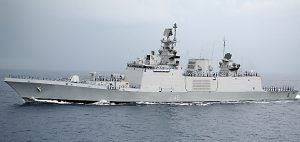
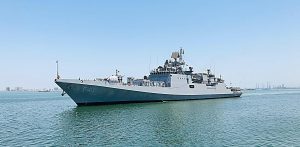
Shivalik & Talwar Class Guided Missile Frigates: Source-Wikipedia
In the class of missile corvettes (a class of warship smaller than the frigate class), four Kamorta Class anti-submarine warfare (ASW) stealth corvettes were constructed under Project 28, which was approved in 2003. These four large corvettes have been built by GRSE and commissioned between 2014 and 2020, with a claimed indigenisation of over 90%. The ship design includes a plethora of stealth ship features, including reductions in acoustic signature and hull vibration. These ships incorporate the ‘X’-shaped hull form to improve stealth, a raft-mounted propulsion system to reduce vibration, and an IR signature suppression system. The latter two ships have their superstructure built from composite material, presently imported from Sweden. This has resulted in increased stealth features and reduced weight relative to typical superstructures built with steel.
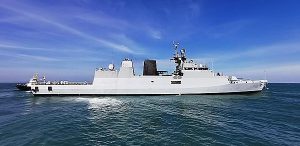
Kamorta Class Stealth Corvette: Source-Wikipedia
In the class of the capital ships, three ships of the Kolkata Class stealth guided missile destroyers (INS Kolkata, INS Kochi & INS Chennai), with a 75% indigenous content, were launched between March 2006 and April 2010 and commissioned between August 2014 and November 2016, at a total cost of Rs. 11,662 Crores. These ships were constructed by MDSL under Project 15A, as a follow-on of the Project 15 Delhi Class destroyers, with similar dimensions but upgraded with over 2300 modifications, including stealth technology, weaponry, sensors and rotary wing systems. The Project 15 A ships were followed by the Visakhapatnam Class of stealth guided-missile destroyers under Project 15B (approved by the Defence Acquisition Council [DAC] in 2009), with improved stealth, automation and ordnance features over the Project 15A ships. Four ships of this class, designed by DND, are being built at MSDL under the ‘Make in India’ theme. The first ship, INS Visakhapatnam, was commissioned on 21 November 2021. This vessel incorporates more stealth features than any other ship in the IN. The second ship, INS Mormugao, has been mentioned at the beginning of this article. The IN plans to induct all four ships into operational service by 2024, at a cost of Rs. 35,800 Crores. All the ships of this class are 163 metres long with a full load displacement of 7,400 tonnes and a top speed of 30 knots (over 55 kmph). The improvements over the Project 15A ships include the relocation of its sonar to the bow from the hull; the mast design which houses the main radar, has also been modified to further reduce its RCS. Other changes include reshaping of the hull to accentuate its stealth features.
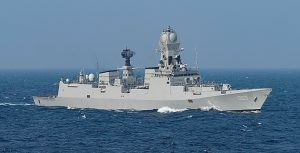
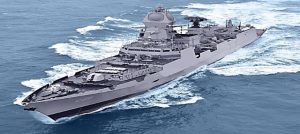
INS Kolkata & INS Visakhapatnam: Source-Wikipedia
India presently has a fleet of 17 stealth ships with another 14 due to be commissioned within this decade.
Global/ Regional Stealth Ship Technology
Sweden has long been considered the frontrunner in stealth ship technology, with their Visby Corvette class ships. This class of ships are full stealth ships and claim to be designed to reduce RCS detection ranges by as much as 99%! In addition, the US Zumwalt Class guided-missile destroyers also incorporate true stealth technology. According to the US Naval Sea Systems Command, while the Zumwalt Class ships are 40% larger than conventional destroyers in the US Navy, the RCS makes them 50 times harder to detect, with signature akin to a fishing boat! Russia is also developing a claimed ‘full-stealth’ corvette, named Merkuriy (Mercury) under Project 20386, with composite and radar absorbing material/ paint and stealth angular design for the superstructure. The ship is likely to be inducted later this year. UK, France, Germany, The Netherlands, Finland, Singapore and Norway are other countries that incorporate stealth technology on their Naval ships.
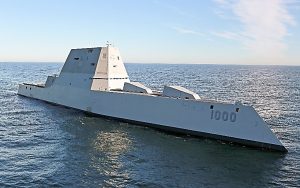

USS Zumwalt & Sweden’s Visby Class Stealth Corvette: Source-Wikipedia
Regional Scan.
- Pakistan has ordered four Tughril Class guided-missile frigates from China. The first ship, PNS Tughril has been launched in January this year, with the balance to be delivered by 2023. These are partial stealth ships with low RCS and would form the mainstay of Pakistan Navy’s surface fleet. These frigates would be equipped for ASW and anti-aircraft warfare. The ships have a displacement of 4200 tons and an operational range of approximately 14,800 Km. Additionally, Pakistan has ordered four Babur Class corvettes based on the MILGEM Project (Turkey’s National Warship Program), which would be manufactured in the Karachi Shipyard. The ships feature a composite superstructure with a steel hull and a stealth hull design that achieves low RCS and low magnetic, acoustic and IR signatures. These ships have a displacement of approximately 2900 tons and an operational range of close to 6500 Km. The first of these was launched in August 2021. Six Jinnah Class corvettes being built at Karachi Shipyard under Transfer of Technology from Turkey, are also likely to have partial stealth characteristics. From the foregoing, it is evident that Pakistan does not have full stealth ships, nor are there any acquisitions likely in the foreseeable future.
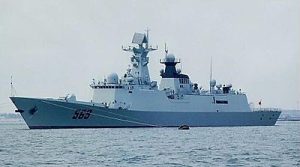
Type 054 A/P Tughril Class Guided Missile Frigate: Source-Wikipedia
- China presently possesses the largest Navy in the world with a combined fleet of close to 800 vessels, three times that of the IN’s present fleet. However, the PLA Navy (PLAN) does not have overwhelming superiority when it comes to stealth ship technology. The Type 055 Destroyers (six in active service) have partial stealth features to include an enclosed forecastle (upper deck) that hides the mooring points/ anchor chains etc. The midship features a continuous, unbroken structure that reduces RCS. The IR signature is diminished by the smokestack design. These ships also incorporate features to reduce acoustic signature. The Type 052C Destroyers (six in active service) and Type 052D destroyers (22 in active service) also incorporate similar stealth features. The Type 054A Frigates, 30 of which are in active service, incorporate a hull design with angled surfaces, radar-absorbent materials and diminished clutter in the superstructure.

Type 055 Destroyer: Source-Wikipedia
Conclusion
In the backdrop of India’s expanding geo-strategic footprint and our established status as ‘net security provider’ in the Indian Ocean Region, it is incumbent that India hones its maritime capabilities to be able to safeguard the country’s littoral and maritime interests. Stealth ship technology could prove an apt ‘threat in being’ with the capability to deter misadventures inimical to India’s maritime interests.
Disclaimer
The opinions expressed in this article are the author’s own and do not reflect the views of Chanakya Forum. All information provided in this article including timeliness, completeness, accuracy, suitability or validity of information referenced therein, is the sole responsibility of the author. www.chanakyaforum.com does not assume any responsibility for the same.
Chanakya Forum is now on . Click here to join our channel (@ChanakyaForum) and stay updated with the latest headlines and articles.
Important
We work round the clock to bring you the finest articles and updates from around the world. There is a team that works tirelessly to ensure that you have a seamless reading experience. But all this costs money. Please support us so that we keep doing what we do best. Happy Reading
Support Us





















POST COMMENTS (0)